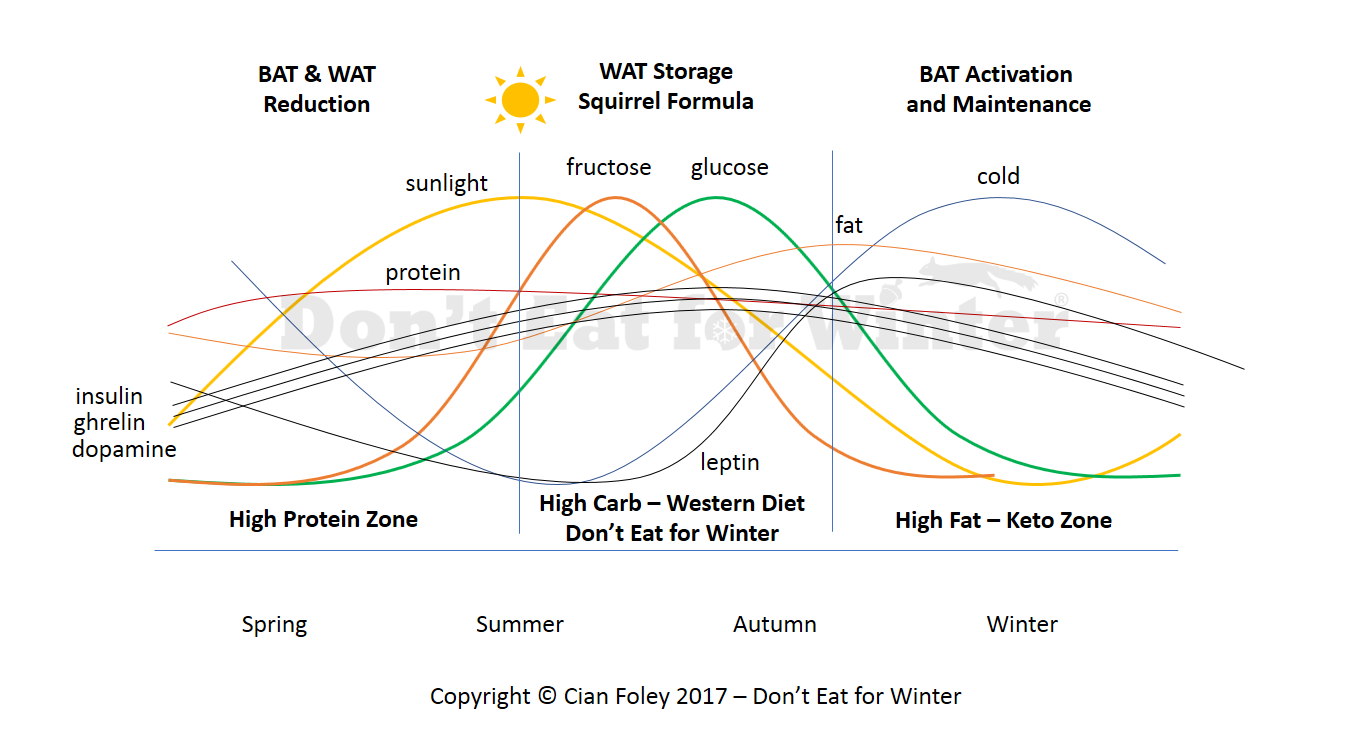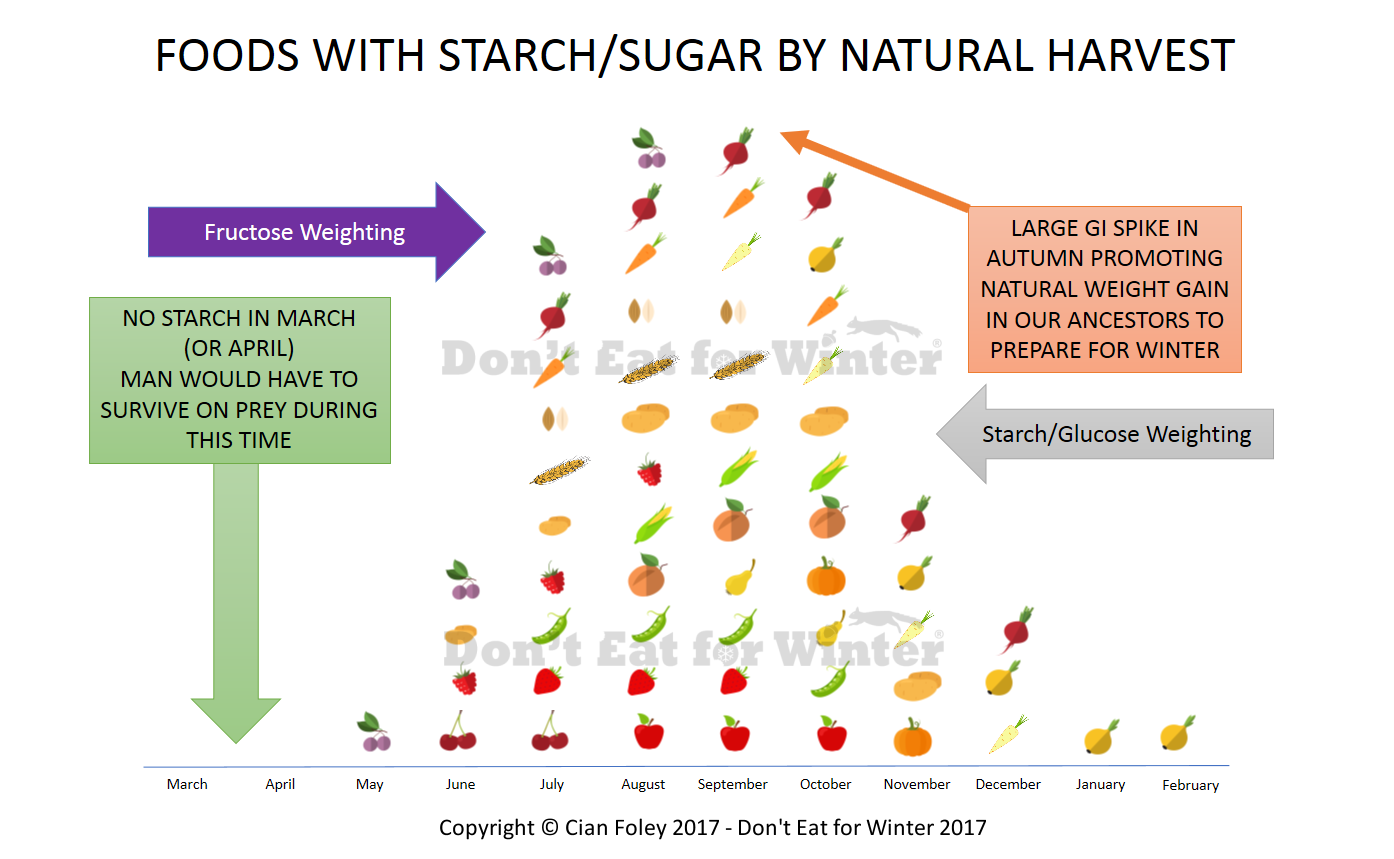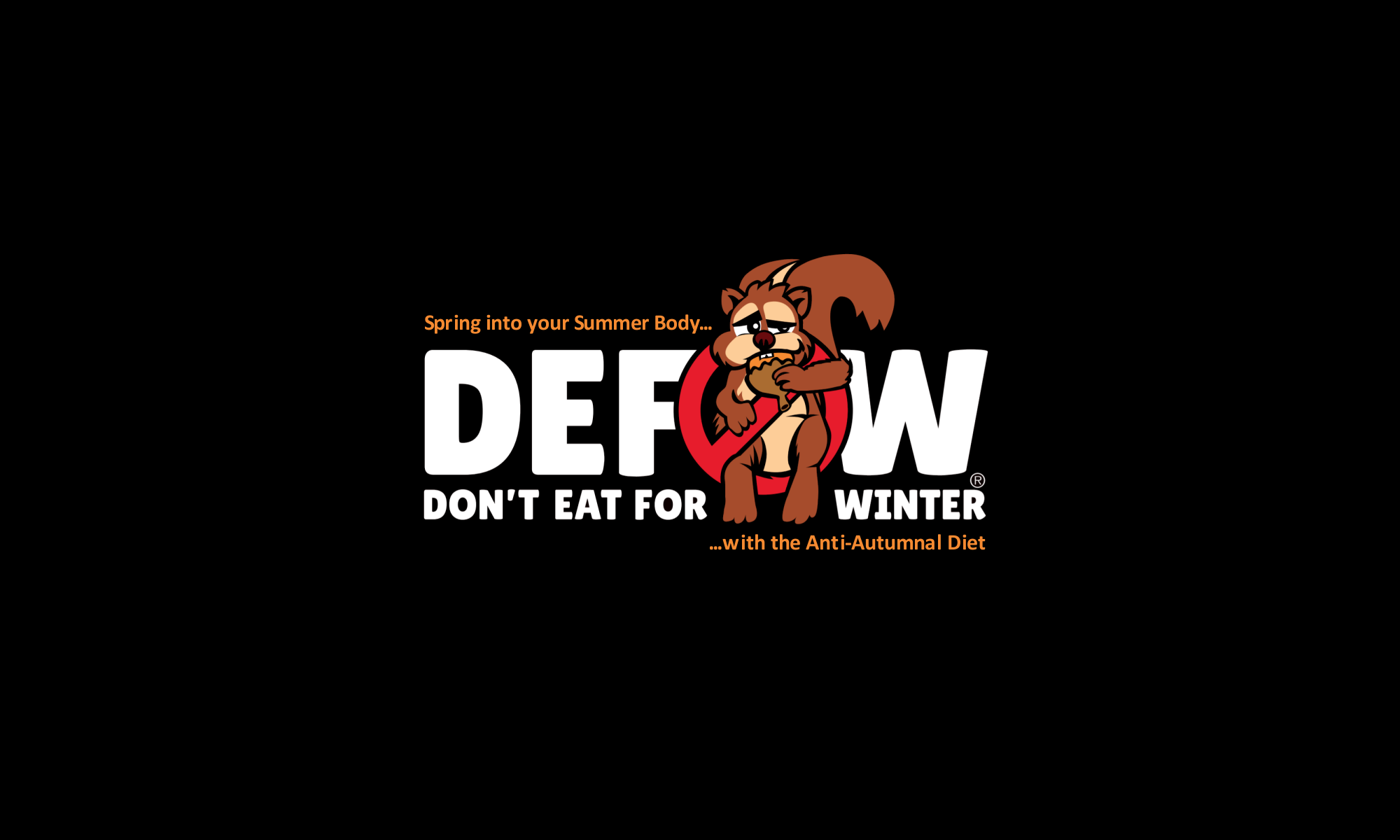In nature, carbs become hyper-available in autumn time, the harvest. A huge spike in sugary and starchy foods becomes available from late summer into autumn – peak sugar. Carbs are a major variable in the stone age diet over the course of the year. These foods cause us to gorge and eat more triggering hormonal and chemical responses in order to guile us into put on a bit of healthy, protective body fat to prepare us for winter for 2 major reasons:
- Back up energy as food sources become scarcer (body-fat is an long-term storage facility for energy).
- Thermal insulation (it has been shown that those with more body-fat can survive longer in colder conditions).
In the modern world, carbs are no longer a variable, they are over-eaten in every meal and snack and not only in natural form, but also in refined form. This means that we live in what I term The Infinite Autumn (on steroids), so we pile on weight indefinitely, preparing our bodies for a winter that never comes. This has resulted in the obesity epidemic we face.
The core message, to control body-fat, therefore is this: Don’t Eat for Winter, at least not all of the time, to prevent invoking these ancient instincts and body processes thus keeping our instincts at bay and body-fat levels optimal.
In 2016 there was an obesity epidemic among squirrels. The winter was mild so their autumn was extended and so they got fatter than normal. Luckily for them the cycle is natural and they use the weight gain in autumn to survive the winter and emerge in the spring ready for action. Imagine if their autumn was extended indefinitely however? What would happen the little critters? They would eventually suffer from obesity related issues as their natural design limits are exceeded.
We don’t have to imagine this scenario though, as in our world, this is what is actually happening to people. In computing terms, when inputs exceed design limitations, the software throws what is known as an exception, in colloquial terms ‘a wobbler’. The statistics regarding the obesity crisis and related issues are staggering and demonstrate that our design cannot handle the input of the modern western diet, an artificial infinite autumn we must endure. However, I’m hopeful that we can actually fix things by taking personal responsibility for our own dietary input and begin to simulate nature as much as is possible in order to stay within our design limitations.
Organ-ism
Our bodies are an hormonal organism, a delicate, complicated instrument that is being played by nature. As we digest food, the tiny molecules absorbed into our bloodstream include amino acids, fats, (sacharrides) sugars, minerals and vitamins, which all play different roles in our bodies. For example arginine, an amino acid will causes the pancreas to secret glucagon, whereas glucose, a monosacharride, will cause the pancreas to secrete insulin. Another sugar: fructose, doesn’t cause an insulin response but can cause a dip in leptin levels, a hunger hormone, which tells the brain how much body-fat we currently have. Fructose also increases ghrelin, another hunger hormone, which tells the brain that our stomachs are empty. A study in 2004 concluded that a diet high in fructose could potentially cause increased hunger, thus increased calorie intake, resulting in weight gain (KL Teff et al, 2004, https://www.ncbi.nlm.nih.gov/pubmed/15181085).
There are a myriad of molecules that affect our bodies in various ways and in various combinations that no single study can ever view in totality. It is like a complex musical instrument on which beautiful chords were played, which transitioned, subtly, through the seasons by a master musician since time began. That genius was nature and she was the composer of the music, the conductor and the musician. The levels to which we thrive are the direct results of the tune.
With our ingenuity, however, the tune is no longer subtle music it is hard-core noise and so it is no wonder we are suffering as we require more and more medication for all the side-effects we cause through our problem solving. This is due to our lack of ability to see all repercussions of our actions because we can never account for all of the variables. All of us need to understand this and admit that we do not know everything, we are finite beings with only a snapshot of knowledge, which become personal truths. This is evident from the confusion between experts, and the totality of the problems we face. Straying from nature always ends badly and we find ourselves medicating for side effects in a never ending cycle, instead of addressing the root problem: we’ve strayed too far from nature. We simply cannot leave well-enough alone.
So what do we do?
a) adapt to this new artificial environment
or
b) simulate natural inputs, thus taming the environment
I opt for the latter because the former option requires a lot of pain, as the adaptation of a species requires lots of hardship and pain over many centuries, which we may never fully achieve as we medicate ourselves to keep us alive.
Don’t Eat for Winter – Extended Hypothesis
I now believe that the core reason we would have put on body-fat, during summer and autumn is as a precursor to fuel the genesis of brown adipose tissue, or BAT for short. To develop BAT requires energy in the form of white adipose tissue, or WAT for short (standard visceral and subcutaneous body-fat). The original reasoning does not change, this simply provides a sharper picture.
I wrote an article previously on BAT describing it as our body’s attic insulation layer. It is a very effective form of body-fat that appears on many mammals that adapted to cold climates and the health benefits developing it are many including longevity. Human babies are born with it, but it was previously thought that it could not be activated in adult humans, however recent research has shown that it can. BAT is an excellent thermal insulation layer, and it activates on humans around the neck and shoulder area, an optimal position for thermal insulation on an upright being in order to maintain body-heat (remember heat rises so it would be no good on the soles of our feet). BAT increases metabolism as the main output of BAT is heat, so as well as being a thermal insulator, it also generates heat, and it’s main source of fuel is WAT. It stands to reason that we would develop BAT for winter to protect us from cold exposure, just like wild animals that adapted to the seasons, however in order to generate BAT we must first create a store of WAT as a precursor. I propose that this is exactly what occurs in nature during the transition from summer to winter based on dietary and other environmental inputs, resulting in specific hormonal and chemical conditions, which are outlined below.
Two recent papers discuss how BAT can be stimulated in in adults humans through:
1. Diet, via a mix of hormonal responses
“Here we report that insulin and leptin act together on hypothalamic neurons to promote WAT browning and weight loss” (G. Dodd et al 2015 https://www.ncbi.nlm.nih.gov/pmc/articles/PMC4453004/)
2. Cold exposure
“Cold exposure activates and recruits BAT in association with increased energy expenditure and decreased body fatness” (M Saito et al , 2016 https://www.ncbi.nlm.nih.gov/pubmed/27697214)
Both of these situations occur naturally as we transition from summer to autumn/winter in climates with pronounced seasons.
Consider the following graph:

This is a simplistic overview of some important inputs to our bodies over the course of the year and resulting hormonal responses. The coloured lines depict average environmental inputs including the main macro-nutrients:
- protein (from natural sources, particularly the staples of meat, fish, poultry)
- fats (from natural animal and plant sources, including nuts in autumn)
- carbohydrates (specifically fructose and glucose from summer and autumn harvests)
and two other important inputs:
- sunlight (affects vitamin D levels and sleep)
- cold (affect activation of BAT)
The black lines depict average levels of major hormones & chemicals responses caused by the inputs including:
- insulin (blood sugar regulation hormone, in response glucose and some aminos)
- leptin (a hunger hormone, in response to body-fat levels, dietary fats and fructose, and other environmental conditions)
- ghrelin (a hunger hormone, in response to food satiety from food inputs and conditions)
- dopamine (to provide a comfort feeling in response to ingesting certain foods)
From this basic picture you can see the kinds of transitions going on and it looks almost musical to some degree, so what is going on.
Let’s take it by the season.
In Spring, our diets would consist of lots of animal based protein, there is not much vegetation at this time of year and carbohydrate sources are not easy to come by (unless you’re good at digging for roots through frozen ground). This is the high protein, carnivore zone, and would be simulated today with low carbohydrate diets. Fats would also have come from animal sources. At this time of year winter fat would be dissipating as the sun begins to climb in the sky and temperatures become milder.
In Summer and Early Autumn, berries and fruits appear, so in addition to the staples of spring, we now have sugar in the form of fructose and glucose becoming available in our diets. This would lower leptin levels increasingly as the summer progresses into early autumn, so as we put on a bit of healthy body-fat, our brains do not notice it happening as our leptin gauge has been altered. Lower leptin levels mean increased hunger and thus more eating. There would also be a more pronounced ghrelin rebound so there would have been less satiety in general (https://www.ncbi.nlm.nih.gov/pubmed/19820013) and, again, more regular eating as a result. Also as the days become long, there would be potentially less sleeping, another factor in driving down leptin and increasing ghrelin levels, tricking us into eat more often during this period. (https://www.ncbi.nlm.nih.gov/pmc/articles/PMC535701/)
As we transition into Autumn, something really interesting occurs. We shift from a fructose weighting to a glucose weighting in terms of carbohydrate intake as fruits decay and starches become more prevalent. See the following diagram of naturally occurring foods with a position on the glycemic index:

The paper mentioned above by G. Dodd et al, 2015 shows that when leptin and insulin levels are high, neurons in the brain are affected which trigger the activation of BAT. It just so happens that these conditions occur naturally at this time, and only this time, of year. We know that fructose lowers leptin levels, and glucose causes increased insulin secretion. so as the summer to autumn transition occurs, leptin levels would bounce back due to the reduction of fructose in the diet. The body-fat increase that occurred during the previous high-fructose period and the introduction of nuts would mean leptin levels elevate rapidly. Insulin levels would also increase due to a continued ingestion of starches such as squashes, grains and late fruits etc. Essentially, just before we move into winter, the dietary conditions exist to begin the activation cycle of BAT. At no other time of the year do these conditions occur.
Aside: It’s worth noting that this time of year is simulated all year round with the western diet, except we’ve refined the foods, which amplify the subtle effects they would have had on stone-age people.
Finally, winter. As the cold increased, and sun reduced we’d become more sedentary and rely more on foods like stored nuts, and prey when necessary. The increased cold exposure would further activate and develop BAT giving us a fully activated thermal insulation assisted with our natural long hair to help us tolerate the cold of winter. This time of year may have been a ketogenic period where we burned fat as our primary fuel source for both anaerobic and aerobic energy. It would make sense, as some studies have shown ketogenic diets increase metabolism potentially increasing the heat we produce internally, thus turning us into high temperature fat burning machines with good insulation to maintain core temperature and fight off hypothermia. Ingestion of fat from stored nuts along with the body-fat stores we would have generated in summer and winter, would therefore have been critical to our survival.
In summary, BAT activation is a natural insulation layer that protects us from the cold. Two conditions occur in nature in autumn that helped stone age humans activate BAT i.e. dietary changes and cold exposure. The dietary conditions that cause raised leptin levels and insulin levels that are more frequent and pronounced only occur naturally during this time. The environmental change of increasing cold also allow us to activate BAT further. Both factors occur during this transition from autumn to winter, aiding our winter survival through the healthy creation of BAT. The dietary conditions of winter would then support the continued fueling of the BAT layer.
In our world, BAT was not discovered until recently because we have removed the natural conditions that caused it to activate.
- Our daily diets have considerable amounts of fructose from table sugar, fruit, and high fructose corn syrups in drinks and snacks which lower leptin levels continually preventing hormonal conditions required to activate BAT.
- We are not exposed to cold anymore due to advanced clothing, bedding, insulated buildings and central heating systems thus preventing cold stimulation of BAT.
Through simulating natural seasonal inputs i.e. reducing dietary fructose and some cold exposure, perhaps we can activate BAT in the autumn time to take advantage of the health benefits brown fat yields, which are many.
Latest posts by Cian (see all)
- The worst macro combination for fat loss - May 11, 2021
- Top 200 Most Fattening Foods (most autumnal) - March 19, 2020
- Is there such a thing as The Perfect Diet? - November 22, 2019
